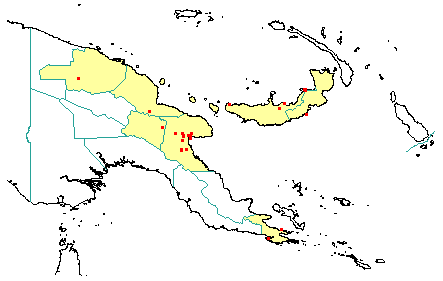
in PNGplants database
PNGTreesKey – Flacourtia zippelii Slooten |
Barry Conn (NSW) & Kipiro Damas (LAE).
Guide to trees of Papua New Guinea
Copyright held by the authors, National Herbarium of New South Wales, and Papua New Guinea National Herbarium
Bijdrage tot de Kennis der Combretaceen en Flacourtiaceen van Nederlandisch-Indië 128 (1919)
Other Literature: H. Sleumer, Flora Malesiana, Series 1, 70 (1954)
Family: Salicaceae
Dicotyledon
Timber Group:
Field Characters: Large canopy tree (up to c. 30 m high) or Small sub-canopy tree (10-20 m high); Bole cylindrical (up to c. 25 cm diam.); straight (bole frequently short, up to c. 10 m long); buttresses sometimes buttresses present or buttresses absent; spines spines absent; aerial roots aerial roots absent; stilt roots stilt roots absent; Bark grey or brown, smooth; Subrhytidome (under-bark) brown; less than 25 mm thick, 15.0-20.0; bark blaze consisting of one layer; faintly to non-aromatic; outer blaze brown, markings absent, granular without splinters; inner blaze brown, markings absent, granular without splinters; bark exudate (sap) absent; terminal buds not enclosed by leaves.
Indumentum: Complex hairs absent; stinging hairs absent; mature twig indumentum (hairs) absent.
Leaves: Leaves spaced along branches, spiral (leaves occurring singly at a node and arranged spirally up the branchlet), simple (a leaf composed of a single blade); petiole present, not winged, attached to base of leaf blade, not swollen; leaves broadest at or near middle or usually broadest below middle, (7.0-) 12.0-21.0 cm, (30.0-) 50.0-70.0 (-90.0) cm; symmetric (to very slightly asymmetric), entire or coarsely crenate, not dissected or lobed, acuminate, venation pinnate, secondary veins open, prominent, intramarginal veins absent; leaves lower surface dark green (sub-glossy), upper surface green, indumentum (hairs) absent; absent; domatia absent; stipules absent.
Flowers: Inflorescence axillary, flowers on an unbranched axis, cones absent; flowers unisexual, unisexual with male and female flowers on the same plant, stalked, flowers with many planes of symmetry, 2.0-3.0 mm long, diameter small (up to10 mm diam.) (c. 2 mm diam.); perianth present, with all sepals and/or petals (hence tepals) similar or petals absent, inner perianth pale yellow, green, or cream-coloured (sepals); 4-5, free or some or partly joined (slightly joined at base); stamens 15 (c.), present, free of each other, free of the perianth; ovary superior, carpels joined (when more than one), locules 4-5; styles free, 4-(usually persistent in fruit)-5.
Fruits: Infrutescence arranged on unbranched axis, fruit 15.0-20.0 mm long, red (dark (edible but bitter), not spiny, non-fleshy to fleshy, simple, indehiscent, drupe; seeds (1-) 2 (-4), to about 5 mm long (5-8 mm long), not winged, broad (as wide as long), seed 1-10 mm diam. (c. 6 mm diam.).
Distribution: East Sepik, Madang, Morobe, Eastern Highlands, Milne Bay, New Britain.
 | Botanical records in PNGplants database |
Notes: Notes Incorrectly referred to as Flacourtia rukam in Havel, J.J. (1975) Forest Botany. Part 2 Botanical Taxonomy (Papua New Guinea Department of Forests: Port Moresby), p. 212. Note: this genus was previously classified in the family Flacourtiaceae.